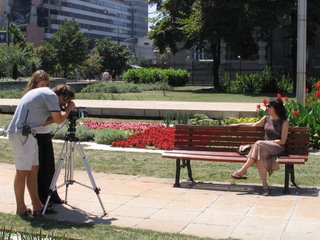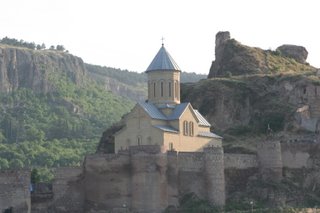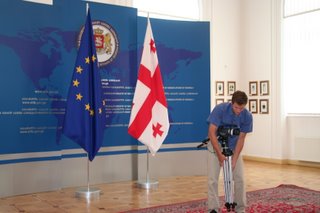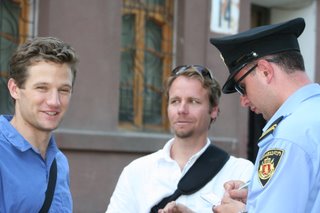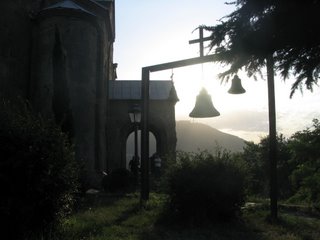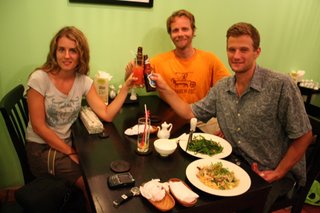 Hello All,
Hello All,See below our last posting from our summer documentary project, this one from our last stop -- Ho Chi Minh City, Vietnam. We've also posted 2 new video clips. We're back in the US now to put our film together; we'll let you know when it's finished and how you can check it out.
Thanks for keeping abreast of our around-the-world adventure -- we've enjoyed sharing it with you, and hearing from some of you along the way.
-- Eleni, Scott, Steve
 HO CHI MINH CITY, VIETNAM: I'm not sure what I expected when I came to Vietnam. Perhaps classic scenes of rice patties, dotted with workers in their conical hats. To be sure, there are plenty of rice patties. But the Vietnam we've experienced is bustling with the energy of country embracing opportunity and making up for lost time.
HO CHI MINH CITY, VIETNAM: I'm not sure what I expected when I came to Vietnam. Perhaps classic scenes of rice patties, dotted with workers in their conical hats. To be sure, there are plenty of rice patties. But the Vietnam we've experienced is bustling with the energy of country embracing opportunity and making up for lost time.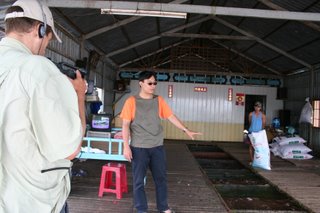 Thanh Nguyen– our KSG profile – straddles the line between Vietnam's past and its future. His grandfather was a prominent military officer in Ho Chi Minh's army during the war with the States and his parents both studied and lived in Cuba with the support of the Soviet Union. Thanh has an unabashed reverence for Ho Chi Minh. Yet, Thanh also has an almost equal enthusiasm for the power of free markets.
Thanh Nguyen– our KSG profile – straddles the line between Vietnam's past and its future. His grandfather was a prominent military officer in Ho Chi Minh's army during the war with the States and his parents both studied and lived in Cuba with the support of the Soviet Union. Thanh has an unabashed reverence for Ho Chi Minh. Yet, Thanh also has an almost equal enthusiasm for the power of free markets. Doi Moi – the "renovation" of the economy by the central government begun in the mid 1980s - is an ongoing, and thus far, enormously successful endeavor. Vietnam went from a country unable to feed its own people in the mid80s, to the largest exporter of rice in the world, the second largest exporter of coffee, and a huge exporter of fruit and fish.
Doi Moi – the "renovation" of the economy by the central government begun in the mid 1980s - is an ongoing, and thus far, enormously successful endeavor. Vietnam went from a country unable to feed its own people in the mid80s, to the largest exporter of rice in the world, the second largest exporter of coffee, and a huge exporter of fruit and fish.We felt the energy of free enterprise in the markets and street vendors of Ho Chi Minh City as well as along the Mekong Delta, Vietnam's bread basket accounting for about one sixth of Vietnams annual GDP. The question of whether Vietnam's economic success will eventually result in political liberalization lingers. Time will tell.
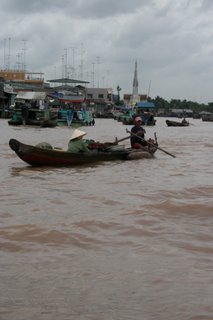 Such weighty questions aside, it's been a fascinating and fun experience here punctuated by daily avacado smoothies, driving rickshaws through the city streets, market
Such weighty questions aside, it's been a fascinating and fun experience here punctuated by daily avacado smoothies, driving rickshaws through the city streets, market  stalls of cleanly shaven pig ear, and a floating fish farm along the Mekong. Thanh's contagious and easy laugh, his willingness to share his insights and stories and his passion for moving Vietnam forward through education and policy research have been a great way to end our project. If political liberalization does someday occur, we wouldn't be surprised to see Thanh in high office.
stalls of cleanly shaven pig ear, and a floating fish farm along the Mekong. Thanh's contagious and easy laugh, his willingness to share his insights and stories and his passion for moving Vietnam forward through education and policy research have been a great way to end our project. If political liberalization does someday occur, we wouldn't be surprised to see Thanh in high office.-Scott
See 2 new VIDEO CLIPS below...








 Jama Masjid was stunning: a courtyard big enough for 25,000 people to kneel and pray, surrounded by beautiful red stone walls and towering minerats, one of which we climbed up to see a beautiful view of the sunset, including the hundreds of kites that dotted the sky as children got in their last hours of play-time before the daylight faded.
Jama Masjid was stunning: a courtyard big enough for 25,000 people to kneel and pray, surrounded by beautiful red stone walls and towering minerats, one of which we climbed up to see a beautiful view of the sunset, including the hundreds of kites that dotted the sky as children got in their last hours of play-time before the daylight faded.
